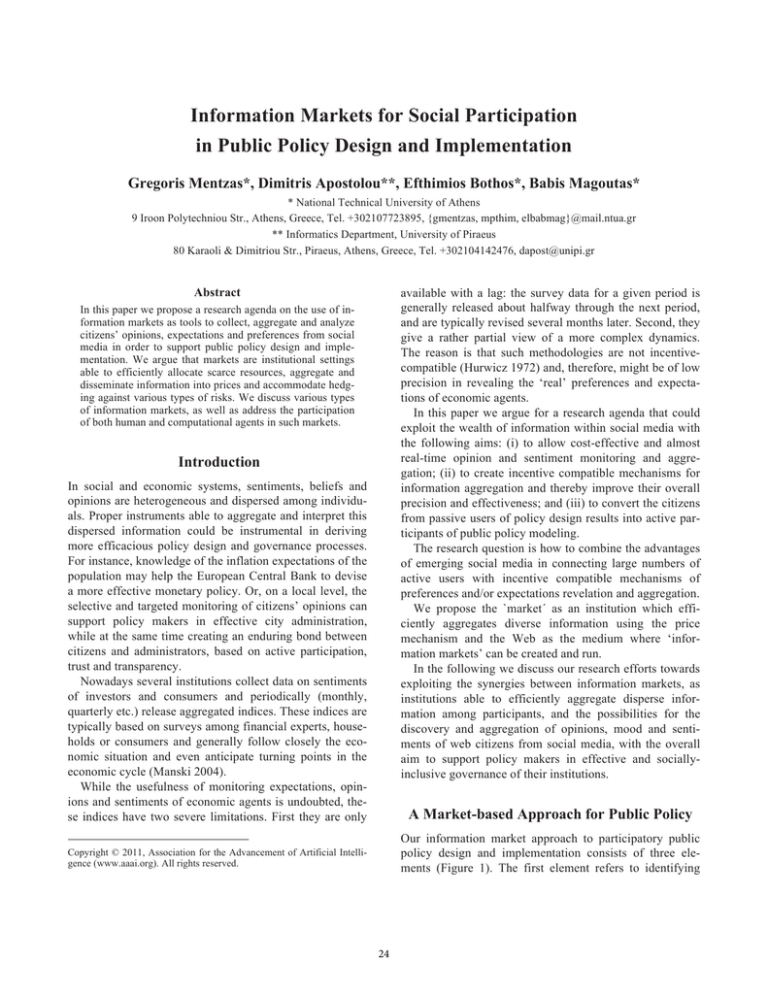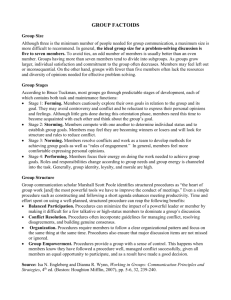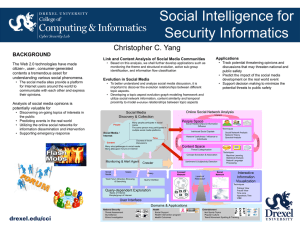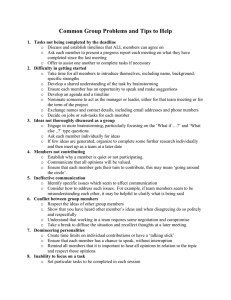Information Markets for Social Participation in Public Policy Design and Implementation
advertisement

Information Markets for Social Participation
in Public Policy Design and Implementation
Gregoris Mentzas*, Dimitris Apostolou**, Efthimios Bothos*, Babis Magoutas*
* National Technical University of Athens
9 Iroon Polytechniou Str., Athens, Greece, Tel. +302107723895, {gmentzas, mpthim, elbabmag}@mail.ntua.gr
** Informatics Department, University of Piraeus
80 Karaoli & Dimitriou Str., Piraeus, Athens, Greece, Tel. +302104142476, dapost@unipi.gr
Abstract
available with a lag: the survey data for a given period is
generally released about halfway through the next period,
and are typically revised several months later. Second, they
give a rather partial view of a more complex dynamics.
The reason is that such methodologies are not incentivecompatible (Hurwicz 1972) and, therefore, might be of low
precision in revealing the ‘real’ preferences and expectations of economic agents.
In this paper we argue for a research agenda that could
exploit the wealth of information within social media with
the following aims: (i) to allow cost-effective and almost
real-time opinion and sentiment monitoring and aggregation; (ii) to create incentive compatible mechanisms for
information aggregation and thereby improve their overall
precision and effectiveness; and (iii) to convert the citizens
from passive users of policy design results into active participants of public policy modeling.
The research question is how to combine the advantages
of emerging social media in connecting large numbers of
active users with incentive compatible mechanisms of
preferences and/or expectations revelation and aggregation.
We propose the `market´ as an institution which efficiently aggregates diverse information using the price
mechanism and the Web as the medium where ‘information markets’ can be created and run.
In the following we discuss our research efforts towards
exploiting the synergies between information markets, as
institutions able to efficiently aggregate disperse information among participants, and the possibilities for the
discovery and aggregation of opinions, mood and sentiments of web citizens from social media, with the overall
aim to support policy makers in effective and sociallyinclusive governance of their institutions.
In this paper we propose a research agenda on the use of information markets as tools to collect, aggregate and analyze
citizens’ opinions, expectations and preferences from social
media in order to support public policy design and implementation. We argue that markets are institutional settings
able to efficiently allocate scarce resources, aggregate and
disseminate information into prices and accommodate hedging against various types of risks. We discuss various types
of information markets, as well as address the participation
of both human and computational agents in such markets.
Introduction
In social and economic systems, sentiments, beliefs and
opinions are heterogeneous and dispersed among individuals. Proper instruments able to aggregate and interpret this
dispersed information could be instrumental in deriving
more efficacious policy design and governance processes.
For instance, knowledge of the inflation expectations of the
population may help the European Central Bank to devise
a more effective monetary policy. Or, on a local level, the
selective and targeted monitoring of citizens’ opinions can
support policy makers in effective city administration,
while at the same time creating an enduring bond between
citizens and administrators, based on active participation,
trust and transparency.
Nowadays several institutions collect data on sentiments
of investors and consumers and periodically (monthly,
quarterly etc.) release aggregated indices. These indices are
typically based on surveys among financial experts, households or consumers and generally follow closely the economic situation and even anticipate turning points in the
economic cycle (Manski 2004).
While the usefulness of monitoring expectations, opinions and sentiments of economic agents is undoubted, these indices have two severe limitations. First they are only
A Market-based Approach for Public Policy
Our information market approach to participatory public
policy design and implementation consists of three elements (Figure 1). The first element refers to identifying
Copyright © 2011, Association for the Advancement of Artificial Intelligence (www.aaai.org). All rights reserved.
24
(Krauss et al. 2008); or forecast box-office revenues by
building regression models (Asur and Huberman 2010).
Our research goal is to utilize web and social media content to predict public policy-related economic and social
indices. The recent work of Choi and Varian (2009) shows
that trends in user queries can provide forecasts on various
business metrics. The potential of search queries to predict
macro-economic indices has also been indicated by Askitas
and Zimmermann (2009) who demonstrate strong correlations between keyword searches and unemployment rates
using monthly German data.
We aspire to leverage user expectations and opinions
which concern policy options and are available on the web
and social media. A critical task is to identify the appropriate information sources and develop information retrieval
tools that are able to cope with various data sources, by
exploiting the contextual information and domain
knowledge attached to them as much as possible. Techniques such as opinion mining and sentiment analysis can
be employed to generate quantitative information from
qualitative user opinions expressed through, e.g., forum
posts and comments.
We aim to use extracted information in order to generate
indexes that represent people’s expectations on issues of
interest for policy makers and policy analysts. Moreover,
extracted information can also be used as input for determining the beliefs of computational agents which will participate in information markets.
social media information sources which include opinions
relevant to the public policy and extracting from them the
appropriate information (cf. A). As a second element (cf.
B), a method for processing content is introduced (e.g.
sentiment analysis for textual input). Third, the market is
set-up and humans (cf. C) and/or computational agents (cf.
D) participate in the trading process. In the following subsections we discuss the research issues and challenges in
each of these elements.
Social Media for Public Policy Indices
Social media has recently exploded as a category of online
discourse where people create content, share it, bookmark
it and network at a prodigious rate (Asur and Huberman
2010). Examples include Facebook, Twitter and a number
of web forums. Because of their ease of use, speed and
reach, social media are changing the public discourse and
set trends and agendas in topics that range from the environment and politics to technology and the entertainment
industry. Social media content contains an untapped collective wisdom that can be exploited, among other things,
for aggregating opinions and preferences on various topics.
The size and diversity of the information found in large
user communities presents an interesting opportunity for
harnessing that data into a form that may support decisions
and choices among different outcomes.
Prior research provides evidence of the predictive capabilities of social media and identifies correlations between
user generated content and the occurrence of future events.
Gruhl et al. (2005) have shown how to generate automated
queries for mining blogs in order to generate indices to
forecast spikes in book sales. Predicting movie sales has
received significant interest as well. Researchers typically
use meta-data information on the movies themselves to
perform the forecasting, see e.g. (Joshi et al. 2010) and
Information Markets for Policy Design
We are interested in markets, not as resource allocation
mechanisms but as an incentive compatible information
revelation and aggregation mechanism. A well-known intuition, which dates back at least to (Hayek 1945) is that in
a competitive market the equilibrium price should be able
!
&
"
'
# ' $
$
%
!(
$
)
! !$$
(
$$ $
Figure 1. User generated content from social media as input in information markets for public policy
25
status of key policy variables. The relevant policy decisions could be private or public whereas markets will provide information related to a variety of public policy matters such as costs, benefits, net benefits of policy options or
the likelihood of certain events depending on the choices
of policy makers.
We aim to design optimal market microstructures and
securities to ensure the citizens’ participation in the markets increasing the capability to aggregate information.
Regarding citizens’ preferences, these will be measured by
trading securities whose prices shall be based upon shares
of choice of policy options. In this setting participants invest on the policy options they prefer rather than expressing their expectations on policy variables. Of course, special consideration has to be given to the design of the securities which will be traded in order to avoid disclosure of
sensitive information. Finally, appropriate mechanisms
should be included to cope with any potential manipulative
behavior of market participants.
to transmit, aggregate and publicize all the private information distributed across a system of dispersed individuals.
Information markets have been developed as tools to elicit
from economics agents the most truthful revelation of their
expectations and knowledge about future events (Wolfers
and Zitzewitz 2004) and represent the ‘wisdom of crowds’
(Surowiecki 2004).
Information Markets are markets designed and run for
the primary purpose of mining and aggregating information scattered among participants and subsequently using this information in the form of market values in order
to make interpretable predictions about specific future
events. Information markets make use of specifically designed contracts that yield payments based on the outcome
of uncertain future events and differ from traditional equity
markets in that they are not typically tied to a claim of corporate ownership. Instead, the assets are claims whose
payoff is tied to some future specified contingency
(Abramowicz 2004).
In recent years, a significant increase has been documented both in the academic literature (Tziralis and
Tatsiopoulos 2007), as well as on practical corporate applications in companies like HP, Microsoft, Google, Siemens
and Eli Lilly which have experimented with information
markets to forecast sales, the success of new products or
even estimate completion time of projects (Tziralis et al.
2008).
The public sector on the other hand seems rather reluctant to introduce information markets in order to improve
public decision making, despite the benefits expected. In
particular, Hanson (2006) proposed information markets as
a new tool that will revolutionize governance, and Ledyard
(2006) and Hahn and Tetlock (2005) describe a framework
and identify the main characteristics an information market
should fulfill in order to perform well in situations relevant
for policy decision making. Possibly one of the reasons for
the public sector’s reluctance to experiment with information markets (at least in the US) is related to the controversy and political debate raised around the Policy Analysis Market (Hanson 2007). Recently, however, the use of
information markets has been suggested as a tool which
can foster the participation of citizens in European public
policy (Millard et al. 2009).
Whereas the forecasting performance of information
markets has been proven when compared to other information mechanisms such as expert opinion, polls and surveys, the application of information markets for policy
matters is associated to research challenges that concern
the problem of liquidity, the need for careful contract designs as well as the requirement of appropriate trading and
incentive mechanisms.
In the research effort we advocate here, we consider
information markets designed to support decisions on policy matters where contracts yield payoffs contingent on the
Preliminary Research Results
We have piloted the use of information markets for public
policy in two occasions. First, we designed and run an information market for public consultation on the use of Information and Communication Technologies (ICT) for
energy efficiency, as part of a participatory policy making
initiative of the European Commission. The purpose was to
allow people to submit and evaluate future research directions relevant to the use of ICT for enabling energy efficiency. Ideas placed in the market had the benefit of being
scrutinized by a wide range of peers. An initial number of
three ideas were used as a seed. Traders were able to enter
new ideas in the first of the three weeks of market operation. Non-monetary and monetary incentives were provided to the idea creators and the market winner. During the
trading period 561 transactions occurred by 63 participants,
a fairly diverse group from 10 European countries, with
wide age span, experience and professional background.
Pilot evaluation through questionnaires and interviews
revealed both a positive feedback from market participants
and EC officers, as well as suggestions for improvement,
such as the possibility to synergistically formulate ideas.
A second pilot focused on re-designing educational policy on religion. The pilot was initiated by a German local
government with the goal to evaluate ideas for re-factoring
the ‘Bible history’ course in high schools. The state officials wanted to modernize the course in order to address
the needs of a multi-religion society. The project was carried out in two phases. Initially a web-based forum was
setup where the citizens could submit ideas and views on
the issue while engaging in an online discussion. The purpose of the forum was to gather citizens’ views and re-
26
Choi, H.; and H. R. Varian, 2009. Predicting the Present with
Google Trends, Technical Report, Google.
Gruhl D.; Guha R.; Kumar R.; Novak J.; and Tomkins A. 2005.
The predictive power of online chatter. In Proceedings of the
eleventh ACM SIGKDD international conference on Knowledge
discovery in data mining, 78-87. ACM Press.
Hahn R. W.; and Tetlock P. C. 2005. Using information markets
to improve public decision making. Harvard Journal of Law and
Public Policy 29: 213-289.
Hanson R. 2006. Decision Markets for Policy Advice. In Patashnik, E.; and Gerber, A. (eds) Promoting the General Welfare,
Brookings Institution Press, Washington D.C.
Hanson, R. 2007. The Policy Analysis Market, A Thwarted Experiment. In Radner, R.; and McGuire, B. The Use of Prediction
Markets for Public Policy, Innovations 2(3): 73-88.
Hayek F.A.v. 1945. The Use of Knowledge in Society. American
Economic Review 35: 519-530.
Hurwicz, L. 1972. On Informationally Decentralized Systems. In
Radner, R.; and McGuire, B. eds. Decision and Organization,
297-336. Amsterdam: North-Holland Press.
Joshi M, Das D.; Gimpel K.; and Smith N. A. 2010. Movie Reviews and Revenues: An Experiment in Text Regression, In Proceedings of HLT '10 Human Language Technologies: The 2010
Annual Conference of the North American Chapter of the Association for Computational Linguistics, 293-296. ACL, Stroudsburg, PA, USA.
Krauss J.; Nann S.; Simon D. and Fischbach K. 2008. Predicting
Movie Success and Academy Awards Through Sentiment and
Social Network Analysis. In Proceedings of the European Conference of Information Systems, 2026–2037. Galway, Ireland.
Ledyard J. 2006. Design of information markets for policy analysis. In Hahn, R.W.; and Tecklock, P.C. eds. Information Markets:
a New Way of Making Decisions. The American Enterprise Institute Press, Washington DC.
Manski, C. F. 2004. Measuring Expectations. Econometrica 72:
1329–1376.
Millard J.; Nielsen M. M.; Warren R.; Smith S.; Macintosh A.;
Tarabanis K.; Tambouris E.; Panopoulou E.; Efpraxia D., and
Parisopoulos K. 2009. European eParticipation Report.
Mpothos, E.; Apostolou, D.; and Mentzas, G. 2010. Using Social
Media to Predict Future Events with Agent-Based Markets. IEEE
Intelligent Systems 25(6): 50-58.
Surowiecki, J. 2004. The Wisdom of Crowds. New York: Random
House.
Tziralis G.; Tatsiopoulos I. 2007. Prediction Markets: An Extended Literature Review. The Journal of Prediction Markets 1: 7591.
Tziralis G.; Vagenas G.; and Ponis S. 2008. Prediction Markets,
an Emerging Web 2.0 Business Model. In Lytras. M. ed. Towards
the Competitive Intelligent Enterprise, 271-291. Springer.
Wolfers J.; and Zitzewitz E. 2004. Prediction markets. Journal of
Economic Perspectives 18(2): 107-126.
mained open for two weeks. Next, contributions were processed by the officials and a set of seven ideas were derived. These seven ideas were represented as contracts in
the market. During two subsequent weeks, participants
expressed their opinion by investing on their preferred ideas but could not propose new ideas. During this period, 43
participants engaged in 302 transactions. Evaluation was
conducted using two different questionnaires, one for citizens and one for state officials. Besides the overall positive
feedback from both citizens and state officials, some concerns that need further examination were raised regarding
possible manipulation effects and speculative bubbles in
the market as well as the fuzzy link between the market
outcome and the actual decision making.
Future Research Directions
In this paper we have sketched an information marketbased approach for social participation in public policy
matters and outlined a number of related research issues.
We believe that human-based information markets are
quite promising as tools for public policy design and impact prediction. Nevertheless, there is still a need for lowering several legal and regulatory barriers to allow their
full use (Arrow et al. 2008).
As discussed above, the application of information markets in policy design can be restrained if participation is
limited and hence liquidity is inadequate, and if no participation incentives are provided. Moreover, information
markets can only aggregate information available to participants and not the wealth of information available on-line.
We believe that a promising research dimension is to
investigate at which extent the use of computational
agents, whose trading behavior is driven by opinions and
sentiments from the Web in general and social media in
particular, can solve such problems. Our early research
results in this direction are quite positive (Bothos, Apostolou, and Mentzas 2010) and point the way towards the
use of artificial markets for aggregating information at a
large scale and enabling socially productive innovation.
References
Abramowicz M. 2004. Information markets, administrative decision making, and predictive cost-benefit analysis. University of
Chicago Law Review 71: 933-940.
Arrow K. J., et al. 2008. The promise of prediction markets. Science 320: 877-878.
Askitas N.; and Zimmermann K. F. 2009. Google Econometrics
and Unemployment Forecasting, Applied Economics Quarterly
55(2): 107-120.
Asur S.; and Huberman B. A. 2010. Predicting the Future with
Social
Media.
HP
Labs
report,
available
at:
www.hpl.hp.com/research/scl/papers/socialmedia/socialmedia.pdf
27




